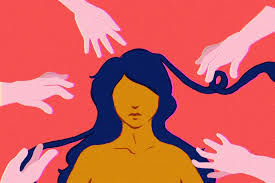Racial Fetishization of Women of Color
- Amisha Patel
- Nov 21, 2019
- 4 min read

One of the topics that we learned about in my LatinX Sexualities class is about racial fetishization of LatinX women. This topic is important to me because it is something I can relate to as an Indian-American woman. The two core texts that we discussed about this issue was Marquillas Cigarreras Cubanas: Nation and Desire in the Nineteenth Century by Alison Fraunhar and Look, blackness in Brazil! by Maria Andrea Dos Santos Soares. The two texts were really eye opening and informative to be because I did not know much about the history of Latinx fetishization.

"The connection between women, sexuality, and fruit, and its double meaning links her lighter than black, darker than white skin color (high yellow) with ripeness and sexual desirability." (Fraunhar 476)
This text really showed how black women were the object of desirability for white men but the black woman had to stay in her place and not take away from a white woman's place. This ideal is still prevalent in today's media of white women desiring and profiting off of black women's features but only the black woman is shamed for it. White women capitalize off of black women and women of color but shame them into silence for being proud of their features. In this article the Mulata is shown as an icon of Latinx racial ambivalence and sexuality, and were circulated as symbols in cuban such as the cigarette packages. They were popularized as the national identity through this type of advertising but the black women were represented as to blame for their oppression through their ascribed hyper-sexuality.

"The introduction of disruptive new visual elements into the ‘stereotyping’ images of blackness can work as a strategy to dismember the fetishistic gaze that celebrates the process of stereotyping blackness and black people." (Soares 76)
This article discussed the modern stereotyping and sexualization of black women in Brazil. This article was very informing to me because I knew little to nothing about the fetishization of black women in Brazil. This article explains the use of the gaze and the disruptive gaze of blackness in Brazil. The mix of Afro-Brazilians led to a mix of the culture that led to the national identity of brazil. Carnaval being a main event that highlights this issue. The national Carnaval queen has always been a light-skinned mulatta woman whereas the local choice is a darker skinned black woman. In a high tourist area, black women are publicized and sexualized to the incoming white men but are not taken into account as the national identity. The voluptuous, lustful, and underdressed woman is always shown as the black woman in Brazilian TV. This boxed image is forced upon the very few black actresses that are prominent on Brazilian TV. Lighter skin is more valued and synonymous with purity compare to darker skin which is an ideal that is prevalent around the world.

"When I became an actress, I quickly realized the world liked their Latinas to look Italian and not like me" -Gina Torres
My personal experience with this topic as an Asian American woman is noticing that many parts of my culture is profited off of and sexualized. As a kid I grew up ashamed of my culture because I would be bullied for it. I remember a time where I had henna on my hand that I wore to school and was made of fun of for it because it looked "gross" or like I had burned my hand. But now with the rise of music festivals and the culture behind it is using henna as an aesthetic and something to make capitalize on. Somethings that I found similar to Indian media and Bollywood compared to the Soares article was the use of putting lighter skinned women to resemble the pure and innocent character and the darker character for negative roles. Growing through Bollywood and Indian, I only saw light-skinned actors and the very little time that I did see a darker skinned character they would be in negative role. For example, the darker skinned woman would always be presented as evil and sexually promiscuous.

Television ads would also push for skin lightening creams with messages conveying that white is beautiful and dark is not. This product was used by many of the women in my family because of the cultural pressure. Having white skin meant being of higher status and it was frowned up for being darker.

In the first article, the theme that I could relate to was the fact that the darker skinned woman was the unofficial national identity. Darker skinned Indian women always represented the everyday women in local ads and television. It was a fact that was hidden from the national identity to present a more Eurocentric ideal to the western world under the white gaze. Even in asian in general lighter sinned woman from East Asia are deemed as more beautiful that women from South and Southeast Asia. Although the two are fetishized in different manners, lighter East Asian women are seen as subservient while darker South Asian women are seen as promiscuous and more "exotic".



Comments